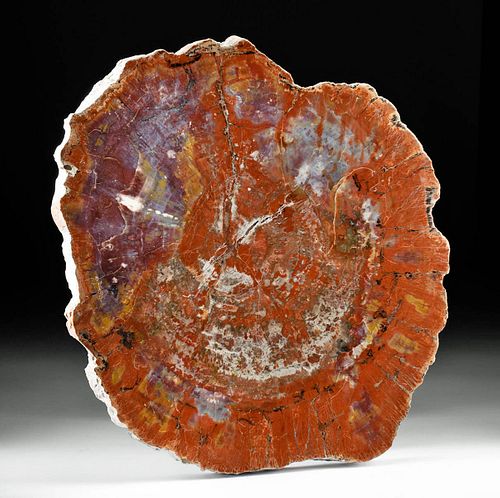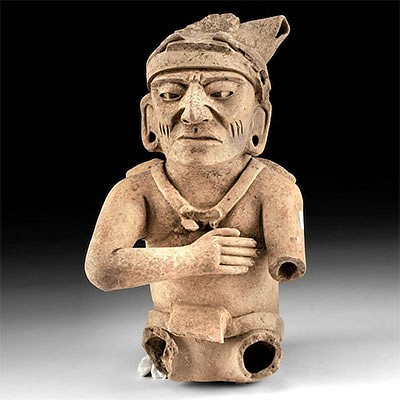Large Triassic Petrified Wood Slab (Arizonan)
Lot 98
About Seller
Artemis Fine Arts
686 S Taylor Ave, Ste 106
Louisville, CO 80027
United States
Selling antiquities, ancient and ethnographic art online since 1993, Artemis Gallery specializes in Classical Antiquities (Egyptian, Greek, Roman, Near Eastern), Asian, Pre-Columbian, African / Tribal / Oceanographic art. Our extensive inventory includes pottery, stone, metal, wood, glass and textil...Read more
Categories
Estimate:
$3,600 - $5,400
Absentee vs Live bid
Two ways to bid:
- Leave a max absentee bid and the platform will bid on your behalf up to your maximum bid during the live auction.
- Bid live during the auction and your bids will be submitted real-time to the auctioneer.
Bid Increments
| Price | Bid Increment |
|---|---|
| $0 | $25 |
| $300 | $50 |
| $1,000 | $100 |
| $2,000 | $250 |
| $5,000 | $500 |
| $10,000 | $1,000 |
| $20,000 | $2,500 |
| $50,000 | $5,000 |
| $100,000 | $10,000 |
| $200,000 | $20,000 |
About Auction
By Artemis Fine Arts
Feb 3, 2022
Set Reminder
2022-02-03 10:00:00
2022-02-03 10:00:00
America/New_York
Bidsquare
Bidsquare : VARIETY SALE | Ancient, Asian, Ethnographic
https://www.bidsquare.com/auctions/artemis-gallery/variety-sale-ancient-asian-ethnographic-8833
Join us for our first sale of February with a spotlight on two fabulous collections, one from Lumberton, Texas, and the other from Whisnant Gallery in New Orleans. Artemis Fine Arts info@artemisfinearts.com
Join us for our first sale of February with a spotlight on two fabulous collections, one from Lumberton, Texas, and the other from Whisnant Gallery in New Orleans. Artemis Fine Arts info@artemisfinearts.com
- Lot Description
North America, Southwestern United States, Arizona, Late Triassic, ca. 225 million years ago. A massive and gorgeous slab of fossilized or petrified tree trunk sliced crossways and highly polished on one of the planar faces to showcase the broad interior rings of the tree - beautiful and astoundingly colorful! The exterior bark is fossilized, replaced by rough stone, while the smooth interior features incredible quartz, and agate formations that replaced the once organic material - creating a vibrant surface. The mesmerizing colors are dominated by warm hues of red, rusty orange, and maroon with creamy white, gray-blue, lilac, and mauve swirls and striations. The flat face is sealed to protect the surface and this slab could be mounted as a tabletop, but the beauty is simply enough to just use as a display piece! Size: 23.5" Diameter x 1.25" W (59.7 cm x 3.2 cm)
Fossilized trees from this time period come from the Chinle Formation of the southwestern USA, and the beautiful colors found in this formation - exemplified by the colors of this fossilized tree - give the Painted Desert of Arizona its name. Due to plate tectonics, this area was near the equator on the supercontinent Pangaea during the Late Triassic, which gave it a humid, sub-tropical climate. It was a floodplain below mountains to its south and a sea to its west; as a result, massive trees washed down from the mountains and came to rest in sediments that preserved them and fossilized them. The petrification process involves the rapid burial of the tree or pieces under sediment which prevents the usual decay. Flooding and volcanic activity are usually responsible for creating the layers of sand, silt, and ash needed to create the right types and amount of sediment. Mineralized water can then permeate through the wood, coating cell walls and filling the intercellular cavities which then fossilizes into stone. The detailed preservation of the wood, including knots, rings, and bark, are possible because the organic wood molecules become coated and surrounded with smaller silica molecules. Nine different species of tree have been identified in the fossilized deposits in the region; this example may be Araucarioxylon arizonicum, an extinct conifer tree (and the state fossil of Arizona). Fascinatingly, the Ancestral Puebloan people who lived in the region approximately 1000 years ago used petrified wood for making tools and even building houses!
Provenance: private Berthoud, Colorado, USA collection
All items legal to buy/sell under U.S. Statute covering cultural patrimony Code 2600, CHAPTER 14, and are guaranteed to be as described or your money back.
A Certificate of Authenticity will accompany all winning bids.
PLEASE NOTE: Due to recent increases of shipments being seized by Australian & German customs (even for items with pre-UNESCO provenance), we will no longer ship most antiquities and ancient Chinese art to Australia & Germany. For categories of items that are acceptable to ship to Australia or Germany, please contact us directly or work with your local customs brokerage firm.
Display stands not described as included/custom in the item description are for photography purposes only and will not be included with the item upon shipping.
#168929Professionally cut and polished with clear sealant over polished face. Other face is covered in protective sealant and the interior rings are not visible. Minor surface chips and abrasions to exterior bark diameter. Amazing coloration throughout.Condition
- Shipping Info
-
All shipping is handled in-house for your convenience. Your invoice from Artemis Gallery will include shipping calculation instructions. If in doubt, please inquire BEFORE bidding for estimated shipping costs for individual items.
-
- Buyer's Premium



 EUR
EUR CAD
CAD AUD
AUD GBP
GBP MXN
MXN HKD
HKD CNY
CNY MYR
MYR SEK
SEK SGD
SGD CHF
CHF THB
THB













